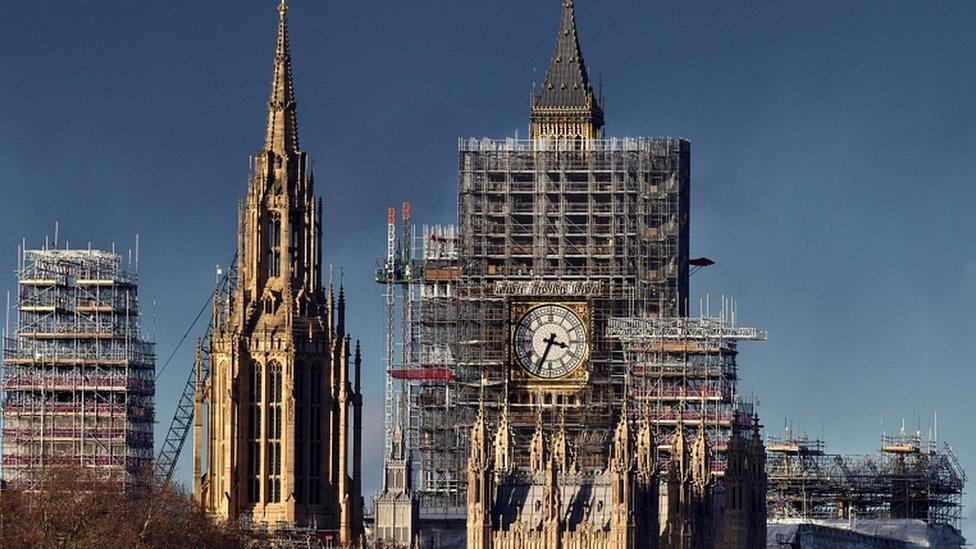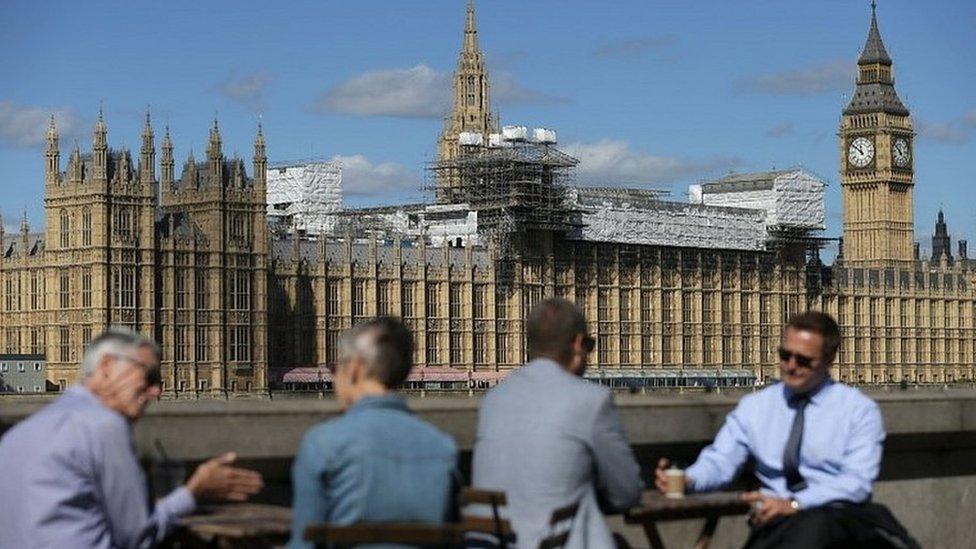Parliament repairs - how much will they cost?
- Published

This week, MPs voted to move out of their iconic Victorian home, the Palace of Westminster, for five years or more, to allow for vital "Restoration and Renewal, external" work.
Next week, the House of Lords will debate the same subject.
If peers sign up, it will be the first time Parliament has moved out of its ancient seat since the Luftwaffe bombed the Commons Chamber in 1941.
Why?
Everyone accepts Parliament's main building is in a terrible state. The roof leaks, the wires crackle, the century-old pipes drip, the structure is riddled with asbestos and the sewage system leaks. A high-powered parliamentary committee warned in 2016 that there was a considerable risk of catastrophic breakdown, which could force the parliamentarians to move out.
How much?
At the moment we're dealing with a figure between £3.5bn and £5.6bn, depending on how the project is approached. The Parliamentary authorities call these "indicative costings", because, like the owners of any ageing property, they are in the position of not knowing what the real scale of the restoration task is, until the floorboards come up and the brickwork is exposed.
How much?
Yes, the estimates run up to £5.6bn. It's an enormous sum of money… but this is a vast building, and one of the most recognisable on the planet. And with all the elaborate stonework, endless wood panelling and opulent Victorian gothic décor, restoration will not be cheap.
Remember, too, this is a UNESCO World Heritage Site, which means it cannot be allowed to simply fall down.
Restoration has to take place regardless of whether MPs and peers stay or go. But one reason a decision has taken so long to emerge is the political nervousness about spending on this scale at a time of austerity and squeezed public services.
Why the variation?
Much depends on whether the work is done around the sitting tenants, the MPs, peers and staff, or whether they are moved out, or whether they leave part of the building but remain in another part.
MPs have just agreed the so-called "total decant option" - moving everyone out for as long as it takes (five to eight years) which is the cheapest option, estimated at £3.52bn.
A two-phase scheme, doing one half of the Palace at a time would (if feasible) cost an estimated £4.42bn over nine to 14 years - and the most expensive would be a rolling programme across 25 to 40 years, costing £5.67bn.
Despite the Commons vote, these options are not entirely off the table, because some MPs might try to revive them, once more detailed costings are available.
And we all know what happens with estimates - the cost or repairs to the Elizabeth Tower, which houses Big Ben, have over-run by £25m.

This picture, from Parliament, shows old pipes, some of which are more than 100 years old and past their life expectancy.
But again this is an example of the way the full extent of the work needed only becomes clear when the builders and engineers can see what's under the surface. And no-one really knows how much it might cost to provide proper 21st century disabled access, for example.
When?
It is going to be a long time before the builders move in.
First, a much more detailed scoping exercise is needed, to establish exactly what needs to be done.
Secondly, there needs to be somewhere for the parliamentarians to move to, if they have to leave the Palace of Westminster - so they won't be moved out before a revamp of some existing office space, and the construction of a temporary chamber. The best guess is that this won't happen until 2025 - and that date could slip.
Could Parliament be forced out before that?
Yes. The fire alarms go off about 60 times a month - and there have been incidents of sewage pipes bursting and of electrical failures.
In the bowels of the building, electrical cables are intertwined with steam pipes from the heating system. One of the major risks is that the steam pipes will crack and short out the building's electrical system. It would then become unusable.
We might well see MPs and peers being led out of the Palace by torchlight.
Where do MPs go?
The current plan is that they will relocate to offices and a temporary chamber in Richmond House, the old Department of Health building directly to the north of the Parliamentary Estate, on Whitehall. This will entail an almost complete rebuild of Richmond House - and the result would be an emergency chamber that MPs could move into if some disaster struck in the future.
Is this a chance to improve the building?
Yes. Clearing out the tangles of redundant wiring, pipes and machinery in the basement levels of the Palace will liberate a great deal of extra space for new uses. This could provide better access for the vast number of visitors to the Palace. Many MPs want a better secondary chamber than the current Westminster Hall, and at the very least a better data network.
Why can't Parliament move somewhere else?
It could, if MPs and peers wanted to. But the experience of the Scottish Parliament demonstrates that new-build parliaments don't come cheap.
A deeper objection is that Parliament is right next to the government - the offices of the main departments are moments away, which means a minister can be summoned to the Chamber at very short notice; accountability would be weakened if ministers took a significant amount of time to get to wherever Parliament moved to. And that's leaving aside the objection to moving away from Westminster, where Parliament has had its permanent home for the best part of 500 years.
If Parliament moves out, might it never get back in? This is one of the central fears for many MPs - but there is talk of writing a guarantee of their return into law.
What is the next move?
A Delivery Authority, modelled on the one which successfully ring-mastered the 2012 Olympics, will now be set up, which will require a bill to go through Parliament. This is the body which will prepare more detailed plans and cost estimates. Hold on to your hats.
Mark D'Arcy presents Radio 4's Today in Parliament at 11.30pm on Friday, where he'll be continuing the debate.



- Published1 February 2018

- Published10 March 2017

- Published3 March 2015
